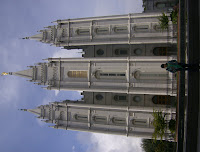Hello everyone!
I am Ekeoma, and I spent 6 weeks of my summer in Upton, New York, at the Brookhaven National Labs (BNL) with chemist Dr. Diane Cabelli. She studies various chemical properties of the enzyme superoxide dismutase (SOD), which is the same enzyme that I work with in my lab at UCLA. My mentor Madhuri, preceptor Joan (Valentine) and I thought it would be a good idea for me to go to Dr. Cabelli's lab, and that it would provide a good experience for me, since I would have the opportunity to work in industry as opposed to academia. And I must say that it was quite an experience!
During my time there, I got to work on a different part of SOD research than I usually do. I got the opportunity to learn pulse radiolysis, a technique which uses a machine (called a van de Graff, shown in the picture below) to generate superoxide radicals. It's a method used to measure the activity of SOD, and indirectly measure its inactivation. (To learn more, you will have to hear my talk during the symposium. ;)
I got some interesting data, but I did not get to work on the specific project that I was supposed to work on while there. In trying to prep for my intended project, I kept running into problems. Because the lab I worked in was a chem lab and not set-up for biochem-type work, I had difficulty preparing the enzymes that I needed, and when I asked my mentor at home to send me the needed enzymes, we incurred one obstacle after another. We, Diane and I, eventually had to tweak the project, but we made the best of what we had available.
Aside from research, I had the opportunity to meet students in some of BNL's summer programs. Honestly, it was great to meet other students like myself that were also interested in scientific research! And I got to learn from some of the other students and other BNL researchers about a field in chemistry, the field of ionic liquids, that I am now taking particular interest in.
Also, I met my (half) sister, Daria, whom I had never before met! It was great! I met her side of the family (sister, brother, mother, cousins), all reside in Brooklyn, and they took to me better than I could have imagined. We went to Coney Island on the fourth of July with her family, I took her to meet our cousins in Washington, D.C. and Maryland, and we spent time with each other throughout my stay.
I must say, even though I enjoyed my stay in New York, and enjoyed meeting up with friends I met during my last visit there, meeting my sister, and meeting new people altogether, I actually, for the first time in my life (that I can recall), got home sick! Yes, home sick! Upton itself is actually not very exciting and is about 60 miles from the city. So, as you may be able to imagine, getting to and from the city was not the easiest task, nor was it the cheapest! We, the other summer students and I, made the best of what we could. Though, there is nothing like home, family and friends that you are most familiar with. Seeing as how I really wanted to go to graduate school on the East Coast, I will now have to seriously consider that option. I enjoyed my experience away from home, but there is no place like home!
I'm glad to be back! =)
...but now, I'm thinking about when next I will go back and visit...funny how that works. =)
Take care, and thanks for reading!





.JPG)
.jpg)

.JPG)
.jpg)







































